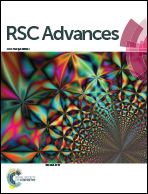Dicarabrol A, dicarabrone C and dipulchellin A, unique sesquiterpene lactone dimers from Carpesium abrotanoides†
Abstract
Three rare sesquiterpene lactone dimers, dicarabrol A (1), dicarabrone C (2) and dipulchellin A (3), were isolated from the whole plants of Carpesium abrotanoides. Their structures were elucidated by comprehensive analyses of NMR and MS spectroscopic data. The structure of dipulchellin A was further confirmed by single-crystal X-ray crystallography. Compounds 1 and 2 possessed an unusual carbon skeleton with two carabranolide moieties linking through a spirotetrahydrofuran ring, which was presumably formed by a [4 + 2] cycloaddition. Compound 3 was a [3 + 2] cycloaddition product of a guaianolide moiety and a carabranolide moiety linking through a cyclopentane ring. Their plausible biosynthetic pathways were also proposed. Compounds 1–3 showed moderate cytotoxicity against HL-60 cells with IC50 values of 8.7 ± 0.3, 8.2 ± 0.3 and 8.9 ± 0.4 μM, respectively.



 Please wait while we load your content...
Please wait while we load your content...